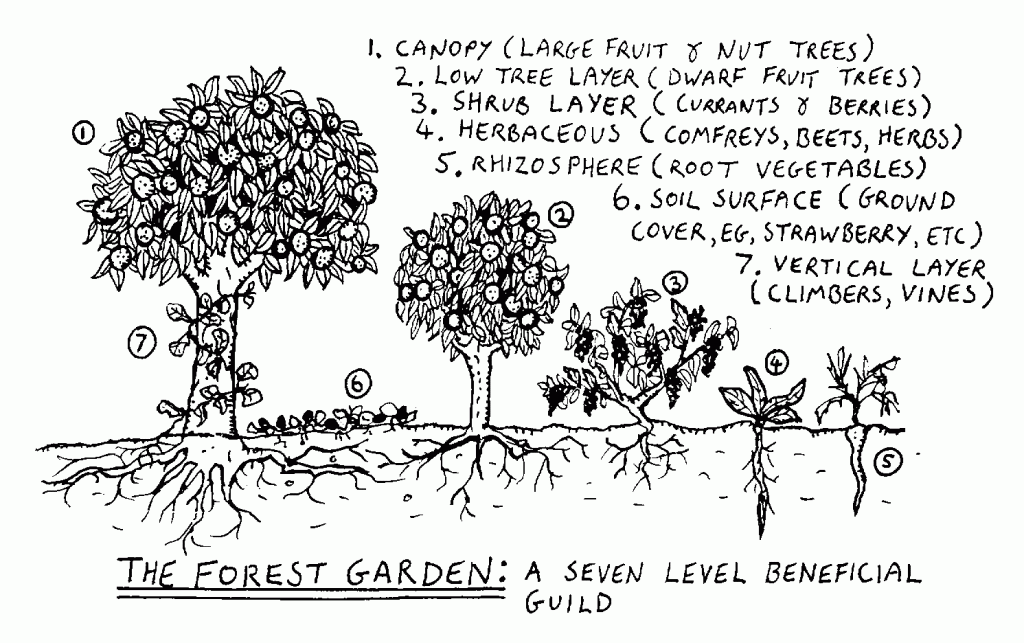Community gardens, agroforestry, physic gardens and no-dig gardening
.
Recently, these pages published excerpts from a very up-to-date piece on food forests from a very active website on gardening and allotments.
Here, the last section mentions the author’s grandfather’s orchard which was a form of food forest dating back long before the latest fad for food forests:
A U.K. Food Forest From The Last Century
Those that say food forests and sylvopastoral systems are new to the U.K. don’t understand our food and farming systems. In Devon and other parts of the U.K. West Country the grazing of sheep and even cattle in orchards goes back centuries as does woodland grazing by cattle and pigs.
My own family also practised food farming in the 1930s and beyond. My grandfather had a five acre orchard in Devon that was primarily used to produce cider apples but had multiple extra crops within it.
Food Forests, Forest Gardens Or Edible Forest Gardens – Bite Sized Gardening
This was covered in a larger piece on these pages looking at the complexity, diversity, variety and richness of such ‘food forests’:
Multi-storey forests – Vision Group for Sidmouth
And the interest in these forests is increasing, especially in the United States:
‘It’s like a place of healing’: the growth of America’s food forests | Food | The Guardian
Here are further pieces from the last fortnight:
Imagine a spot in San Antonio where cyclists cruising along the River Walk’s Mission Reach can stop in a shaded area where dense fruit trees are growing tall and sprouting nutty pecans or juicy figs. The trees’ harvest, open to any passersby, offers free, healthy options like peaches, plums, papaws and persimmons.
For the past few years, Mitch Hagney has been working on making that vision a reality, and on Sunday his plans will finally come to fruition — or at least to seedling. As president of the Food Policy Council of San Antonio, Hagney has been working with the city and county to secure the space and funding to plant San Antonio’s first urban “food forest,” a type of perennial garden aimed at addressing food inequity…
Nonprofit will plant city’s first ‘food forest’ this weekend
The Education Fund, a nonprofit dedicated to developing innovative programs for public school students and educators in Miami-Dade County, recently receiving a $1 million USD grant for its “Edible Outdoor Eco-labs to Accelerate Learning” programming.
Through these Eco-labs, which are forest gardens installed on school grounds, The Education Fund provides students with hands-on lessons in science. Accelerating students’ academic success — with 67 percent of students improving their science proficiency — the program also brings native fresh food and tree canopy to concrete-ridden neighborhoods in Miami-Dade County.
But it’s also getting big in Britain – again, with these stories from the last fortnight:
Raithwaite Sandsend Hotel, in partnership with Sapling Spirits, has created the UK’s very first hotel Forest Garden – to sustainably feed the hotel’s kitchen year-round. More than 500 trees and shrubs have been planted in the grounds in the hotel’s 100-acre estate to create a beautiful and biodiverse edible landscape for the hotel’s chefs and mixologists to pick from…
Raithwaite Sandsend, near Whitby, creates UK’s first hotel forest garden | The Scarborough News
From providing food to those in need to transforming public land, gardens have more uses than ever. Here, we look at some of the new ways old skills are being applied to benefit everyone
Community gardens
“If you want to have a chat and a cup of tea, you can, if you want to put your hands in the dirt you can,” says Denise Farrell, site manager at the Wolves Lane Centre, a community garden of glasshouses and planting beds set within the suburbs of Wood Green, north London…
Agroforestry
You don’t need a forest to start a forest garden. Also known as a food-forest, or an agroforest, it’s an approach to gardening that imitates the structure of a natural forest and you can apply its principles to a space as small as your balcony or backyard. In essence, it’s a system for growing where multiple layers of trees, shrubs and ground plants work together in an integrated and self-sustaining way…
Physic garden
Modern medicine evolved from the carefully tended soil of physic gardens. These were cultivated across Europe from the 16th century on to teach apprentice apothecaries how to identify and grow plants with healing properties. According to Nell Jones, head of plant collections at London’s Chelsea Physic Garden, they were essentially “a training ground for the precursors to modern day doctors and pharmacists”…
No-dig gardening
Dig your soil and you’re causing active damage to a complex ecosystem. “You kill centipedes, millipedes, spiders” and other tiny creatures, says Charles Dowding, the UK’s best-known advocate for no-dig gardening. “You’re also breaking the mycelial threads that make up the fungal networks – that’s a key mechanism for how plants feed.”
A growing revolution: new ways of using the land | Life and style | The Guardian
Finally, this is one way to see it:
